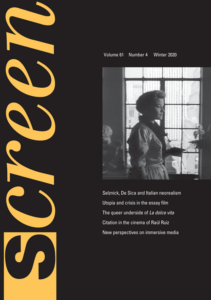
Absorbed in experience: new perspectives on immersive media – Screen Volume 61, Issue 4
Publication | Table des matières | Critiques
Résumé
What is it about the topic of immersion and art that simultaneously raises so much enthusiasm and suspicion? Not only is immersion arguably a central feature of the human ability to imagine, it has also been – as far as history permits us to ascertain from images and written words – an evolving apparatus for the imagination itself. From Plato’s Cave to the head-mounted display, the pursuit of experiences that transcend reality has been the driving force of cultural production and a myriad of related technologies. The pairing of art and immersion is hardly new, yet from the 19th century onwards the increasing combination of art with technology has given immersion a progressively more fundamental and structural dimension.1 With the aid of computer-generated imaging and an array of interactive and 3D technologies, immersive art has also become markedly more architectural in nature.2 Immersion now typically offers itself in the form of various enfolding, multisensorial environments to be entered and experienced, in contrast to the traditional ‘bounded’ (framed, screened) image to be watched or looked at from a distance. Sound in the cinema can take on the characteristics of immersive art forms too, particularly when distributed through a large, synchronized audio system. But the conventional cinema image is always circumscribed by the screen. As spectators, we retain the possibility of looking elsewhere and reconnecting with the surrounding reality, beyond the film’s fictional world. At the same time, we still need to place ourselves and stay in a particular pre-determined field of view in order to see the image properly. In an immersive environment the frame, as a material threshold between the virtual world and reality, disappears. What remains are the peripheral boundaries of my own vision, which in virtual reality (VR), for instance, I can expand by moving my head and body around to shift the horizon of my view. VR and 360-degree film3 thus produce seemingly self-contained milieux through which I, as an ‘experiencer’ rather than a spectator, can apparently move, and with which I can sometimes interact.4 As such, immersive art has the potential to make us experience things anew, to rethink how we perceive and use our bodies, and how we relate to other technology-saturated and mediated surroundings.
Table des matières
- Absorbed in experience: new perspectives on immersive media Introduction
Martine BeugnetLily Hibberd
Screen, Volume 61, Issue 4, Winter 2020, Pages 586–593, https://doi.org/10.1093/screen/hjaa054View article
- Towards an-iconology: the image as environment
Andrea Pinotti
Screen, Volume 61, Issue 4, Winter 2020, Pages 594–603, https://doi.org/10.1093/screen/hjaa060
View article
- Interview with Alejandro G. Iñárritu
Martine BeugnetLily HibberdScreen, Volume 61, Issue 4, Winter 2020, Pages 604–614, https://doi.org/10.1093/screen/hjaa056
View article
- ‘Real-time’ virtual reality and the limits of immersion
Richard MisekScreen, Volume 61, Issue 4, Winter 2020, Pages 615–624, https://doi.org/10.1093/screen/hjaa058
View article
- Togetherness?
Adrian Martin
Screen, Volume 61, Issue 4, Winter 2020, Pages 625–634, https://doi.org/10.1093/screen/hjaa059
View article
- Prosthetic architectures of the senses: museums and immersion
Sarah KenderdineScreen, Volume 61, Issue 4, Winter 2020, Pages 635–645, https://doi.org/10.1093/screen/hjaa057
View article
Critiques
- “This important volume from an authoritative international team of authors sheds significant new light on the comparative development of post-war Conservatism in the western world.”
– Stuart Ball, Professor Emeritus, University of Leicester, UK - “The rich essays collected in this illuminating volume show that the rise of right-wing politics in the United Kingdom, the United States, and France since the 1970s was a remarkably transnational phenomenon. As they attacked social democracy and cultural pluralism, right-wing movements borrowed ideas, visions, vocabularies, and tactics from each other, adapting them to their own national idioms and using advances in one country to win advances elsewhere. Anyone interested in confronting the problems that have proliferated in the wake the right’s reconfiguration of politics – surging inequality, belligerent ethno-nationalism, worker disempowerment and insecurity, and lost faith in the capacity for democratic self-government – has much to learn about the origins of these problems from this important book.”
– Joseph A. McCartin, Georgetown University, USA, author of Collision Course
